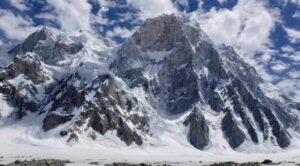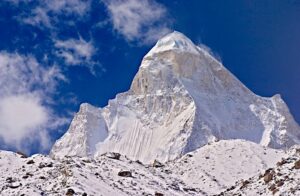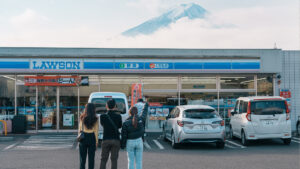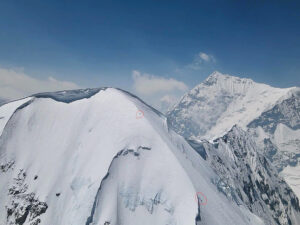Top Tips, and challenging sections in the heart of the Canadian Arctic winter.
(By Correne Coetzer) Adventure couple, Benjamin Weber and Natalia Almeida, started their winter crossing of Canada from the Southern border with the US to Resolute Bay well inside the Arctic Circle on Decmber 21. They started off on bicycles and when they get to Thompson, the couple will switch to skis and sleds.
Explorersweb caught up with Ben and Natalia asking them for their Top Tips from their recent 3600 km cycle trip through South America and Top Tips from their polar mentors and trainers. The couple also talks about their gear and the challenging sections in the heart of the Canadian Arctic winter.
Explorersweb: You have cycled 40 days, over 3600 km, from the city of São Paulo in Brazil to Santiago, Chile, via Buenos Aires in Argentina. What have you learned from this journey through South America? Top Tips that you would give to other cyclists?
Ben and Natalia: Know how much weight your bike can take: if you have too much weight on your bike your spokes will break (and make sure you do take plenty of spare spokes anyway – we thought we had too many spokes with us (around 14) though we still used about half of them!), and your rims will also deteriorate quicker. Remember that most of the weight will be concentrated on the rear wheel.
Related to this, we were using 700cc wheels on bikes with which we had also toured the UK in winter. However, 700cc wheels are not as strong as 26” and are harder to get spare parts for, especially in South America. Fortunately we had most of the parts we needed, but still, we have got 26” bikes now.
Take a good technical course, or practice making a bike and taking it to pieces again, so you know what to do if any problems arise. Make sure you have the basic tools such as free wheel key. A spoke broke on me on the free wheel side of the rear wheel and I didn’t have it, meaning that it was very hard to take off. Adjusting the other spokes around it meant that we got the wheel more-or-less true again until we got somewhere that could adjust it, but wasn’t perfect.
Don’t count on anybody else having the knowledge to help you with more technical repairs. While you will definitely find plenty of very nice people who will offer to help, be careful lest they make things worse!
Explorersweb: Ben, why does Natalie make a good team mate? Natalie, why does Ben make a good team mate?
Ben: Natalia is great at organizing and is very practical, able to improvise with things we have got in order to repair something or make something better; I can be quite ambitious and maybe overestimate what we can do, while Natalia helps calm me down and see more angles before taking the plunge and doing something.
She has a fantastic sense of humour and this helps us both keep going when things aren’t great, and indeed when I am worried or down about something, she definitely helps me to keep looking to the positive.
Natalia: Ben is great at planning and researching the project and route, making sure we know what to expect and what we are getting ourselves in for; he knows and respects my limits – I am less strong than he is, and he understands this and we both recognise the importance of working together to get to the end of the day feeling as tired as each other (ie, he’ll take more weight than me so I don’t complain!!). He has also a good sense of humour that helps to make everything easier, and his determination also helps keep me going.
Both: we both know each other very well and we can see each other’s mood, how to react to each other and help each other – something quite important especially in the isolation of such expeditions where we only have each other’s company. We are able to talk with each other about the day’s progress, what happened when something didn’t go according to plan, how we can improve on a day or conversely, enjoy things when all goes well.
Now you are busy with you last preparations for your winter cycle and ski. You have trained with the McNair family, Matty, Sarah and Eric, at Iqaluit on Baffin Island. Three or more Winter Tips from them?
If you sweat, you die! Keep control of your body temperature all day when you are travelling and at night when you go to sleep, so you don’t sweat. Start off on the cooler side of comfortable so when you heat up as your body starts working harder, you don’t over heat and start sweating. Again, sleep cooler than you would normally want to.
Go and pee when you need to! – don’t try to keep it in (even when you are nice and comfortable in your sleeping bag, get out and go pee!) – you will waste energy if you don’t.
Enjoy yourself! Life is hard enough on the ice and in the cold without being all negative about things – look to the positive and enjoy the hardship!
(Oh, and don’t sweat!!!!)
What type of bicycles do you use?
We are using touring bikes made for us by Oxford Bike Works – steel framed with 26” wheels and dynamo hubs – definitely wanted the dynamo hubs because battery life in the extreme cold is so reduced and visibility in will also be limited especially with the shorter days. Tubus racks on front and rear, and one of us with a Bob Ibex trailer for the bulky equipment like the tent and kitchen box.
What do you wear and in particular what shoes will you cycle with?
Very good question with the boots – this is something we have thought a lot about. We have decided in the end not to actually use special cycle boots. Though we used them in the South America ride, we’ll be using insulated Baffin boots, basically because of the extremely cold temperatures we will face.
We’ll keep our Rab windsuits on during the ride, though reflective bands around the legs to stop the fabric getting caught up in the gears.
The further north you go the less inhabited places you get. What is the most food and fuel that you will be carrying in your panniers?
We will be carrying 21 days worth of food at the start of the ride from Emerson to Churchill, though we will carry less gas – budgeting about a 1.25 litres a day (we will use much less (.75l), but basically to account for any weather delays keeping us tent-bound): so enough to get us to Thompson (6 days – and a bit less than a litre a day), where we will supply to get to Gillam (5 days), and (while it is shorter going to Churchill – only around 300 km – we’ll be going along tracks so it won’t be smooth and will most likely be slower and there won’t really be anywhere in between where we can resupply, so enough for around 10-12 days).
Where will you switch over to skis? How will your route look like from there? How much sea ice will you cross? How much food will you take with?
We’ll switch to skis once we get to Thompson. From there we’ll be on the coastal ice of the Hudson Bay, heading north for about 480 km, passing Arviat and up to Rankin Inlet. From there we’ll get off the sea ice and cut across the tundra almost directly north to Taloyoak (about 860km).
After resupplying there, we will be on the sea ice pretty much until the end of the journey at Resolute – just about 765 km as it will be too hilly to take the direct route over land, and we’ll head out to the west of Taloyoak before heading north up the channel towards the Lancaster Sound.
This will probably the trickiest part of the journey due to the currents pushing the ice around up there, and higher possibilities of water leads to cross. We will resupply at Rankin and Taloyoak, but at most we’ll carry food supplies for around 55 days of supplies with us – again to take into account any possible weather delays. [Ed note: to compare: 55 days of food unassisted would be enough for a 10 degree of latitude Hercules Inlet route expedition to the South Pole.]
Rankin is known for its severe storms (in January 2008 Rankin recorded the longest ever blizzard in Canada, with seven days of sustained 75 km/h winds, and gusts reaching over 90 km/h, and also it’s recorded the worst wind-chill we’ve seen in the region, -70.5ºC in February), and we’ll be going through that region when things will be at their worst so we need to be prepared. At most, our sleds will weigh about 90 kg.
Explorersweb: Gear?
Tent: North Face VE 25 (modified with snow flaps)
Sled: Acapulka Polar Challenge 170
Skis: Fischer 109s and 99s
Clothes:
Rab windsuit
PH Designs: Denali Down Jacket, Salopettes, fleece trousers
North Face fleece / MEC light down hoodie
Boots:
Baffin Polar series boots
Explorersweb: Anything else?
We are taking Ozone (6m, 9m and 13m) kites with us as we want to practice kite-skiing, though considering we don’t have much experience with this (we only had limited time in Iqaluit last time, and it has been hard to do anything since).
We are budgeting our food and gas supplies as if this is not the mode of transport. Here’s hoping we’ll do well with them though – and even if we manage a couple of days of only say 20-30 nautical miles with them (I know, much slower than what is possible to do with kites, but still!) we would be happy.
Follow Ben and Natalia’s blog updates in the News Feed at Explorersweb.
Biographies courtesy the team website:
Benjamin Weber grew up in the Orkney Islands in northern Scotland, is a Fellow of the Royal Geographical Society and a member of the Brazilian Adventure Society. While not training, he works as a consultant, supporting companies coming to Brazil dealing with a complex business and political environment. He is a born adventurer! Climbing two metre walls when just a toddler (parents looking on and taking pictures rather than grabbing him…….), and has always sought out adventure; living and travelling throughout Asia and Russia, South and North America; enjoying the challenges of sports like extreme altitude mountaineering and long distance bike touring.
Natalia Almeida is a skilled and experienced television editor and at the same time, a great technical climber. She has led the editing teams of many mainstream TV programs in Brazil such as those covering the Brazilian car rally, the Rally dos Sertões – going through the dry back country of the Brazilian north-east, and Policia 24h – a program accompanying police in São Paulo and Rio de Janeiro as they face the massive risks of their work. Like Ben, Nat has a keen adventurous streak. Though she had never been higher than 2000m above sea-level, she readily acclimatized and climbed in the extreme heights of the Bolivian Andes, and she faced the winter Land’s End-John O’Groats bike tour with relish!






